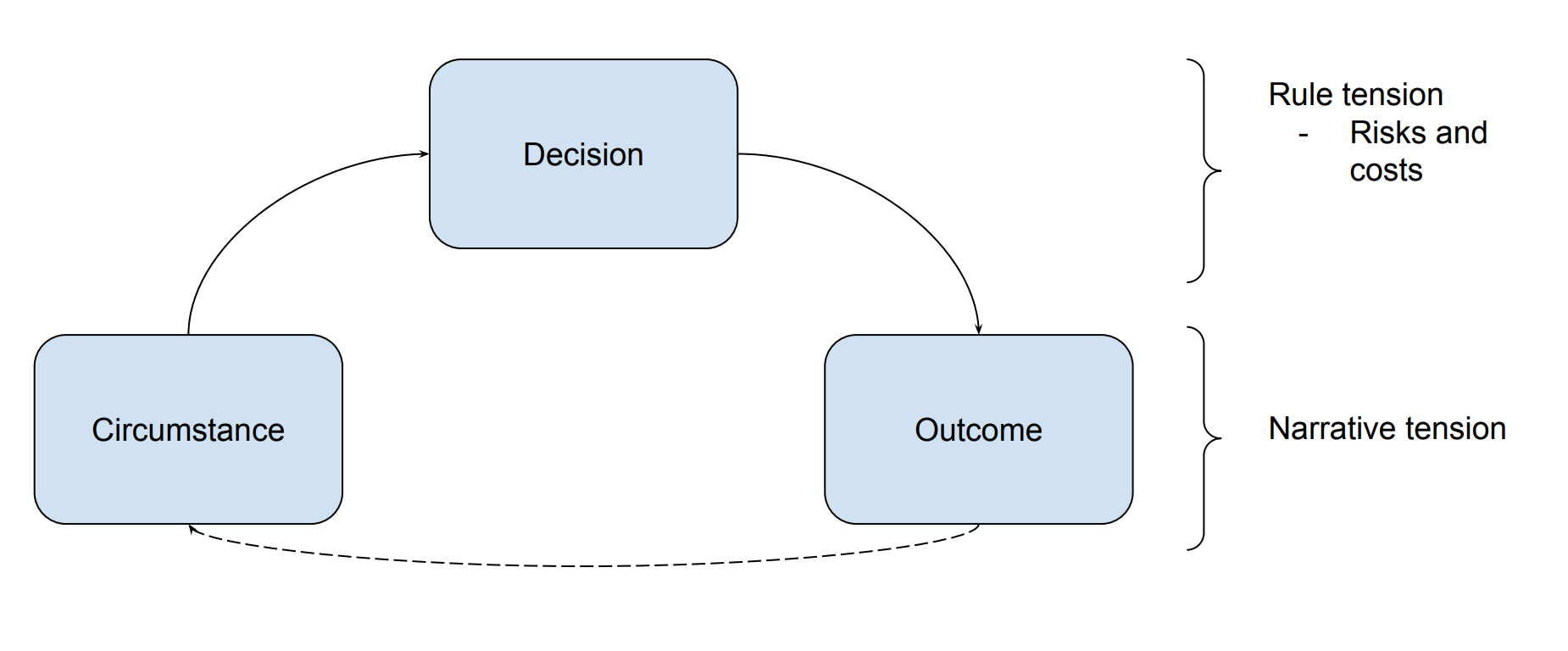Introduction
Most advice about how to create tension in role-playing games is about the narrative: make things personal, raise the stakes, or create a sense of paranoia.1 But the rules of a system also create tension. The risky dice roll to kill the boss or the bold tactic to turn the tide increases the tension set by the narrative.
In this post, I’ll show that role-playing systems use risk and cost to increase the tension felt by players. My goal is to provide a tool Dungeon Masters can use to make better campaigns and encounters, like Justin Alexander’s Node-Based Scenario Design for investigative role-playing games.
Encounter Model
To see how rules impact tension, let’s look at a model of role-playing encounters.

Circumstance, Decision, Outcome is a three-stage encounter model.2 As you will see below, the model applies to micro and macro encounters. It’s relevant when a player decides to cast fireball in a round of combat and when the party decides to storm a lair.
Circumstance: The guard walks into the shop and sees you with the jewels.
The circumstance is the situation described to the player. It controls the degree of tension: confronting the villian to save the world is more tense than sneaking past a guard to steal gold.
Decision: I attempt to jump through the window and flee.
The decision is the choice the player makes in that moment. The rules determine the risk and cost of the decision, increasing the tension.
Outcome: You jump through the open window and land gracefully in front of a squard of guards.
The outcome is what happens after the decision. When the outcome is good and the tension was high, players feel victorious. When the outcome is bad, players feel defeated. If the outcome is bad, a good way to keep the game moving is by failing forward. This is when the tension is delayed or increased and the outcome becomes the new circumstance.3
Decision Tension
When a player makes a decision, they have a desired outcome. Rules are designed so the outcome is not guaranteed, or the decision may lead to a worse outcome in the future. These risks and costs are how game mechanics create tension.
Risk
There are two ways rules influence risk: by adding a random chance of failure and by increasing the likelihood of mistakes via game complexity.
A pure random chance of failure is tense–think Russian roulette. This kind of tension happens when players have no control and wish they did. This, however, is tension of circumstance not decision. Tension is decision tension only when the player willingly chooses the risky option.
The fear of making mistakes also increases tension. Mistakes occur when the situation is complex and the wrong decision could lead to failure. When players opt for a complicated tactic or have to choose the right spell out of dozens there is a risk they made a mistake. The tension here can also manifest outside the narrative: the fear of looking stupid or the opportunity to look smart.
Most role-playing systems combine randomness and complexity to heighten the tension, and these are the ones I like. I want my players to think “I hope this works!”
Costs
A decision has a cost if it depletes a resource managed by the game rules. Players may fear that spending this resource was a mistake, increasing the tension as I described above. The difference is that rules prevent the same decision from being made in the future. Whereas if the decision didn’t have a cost, the choice can be made again if the circumstance allows.4
Costs increase tension now and in the future. For example, if a player spends a 9th level spell slot they pray for a good outcome, because they won’t get the chance again. Likewise, the loss raises tension in future encounters, because they may wish they had that resource–tension from regret.
Conclusion
By identifying the rules that increase tension, I can more easily chose and describe systems that are a good fit for my party and campagin. The next post in this series will use the encounter model to show why Gumshoe is a great system for investigative role-playing games.
Stackexchange: How can I increase tension. Tribality: How to create tension in your game.↩︎
Justin Alexander argues that this model is the fundamental element of an RPG.↩︎
For example, the players stormed the villian’s lair and were defeated. The outcome is that the villian summoned the demon and locked the party in the dungeon. The new circumstance is that they must escape the dungeon and defeat both the villian and the demon.↩︎
Another way to think about it: mistakes without mechanical costs are only opportunity costs.↩︎